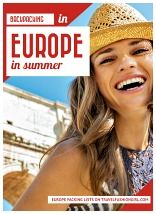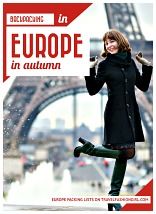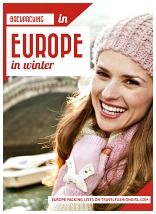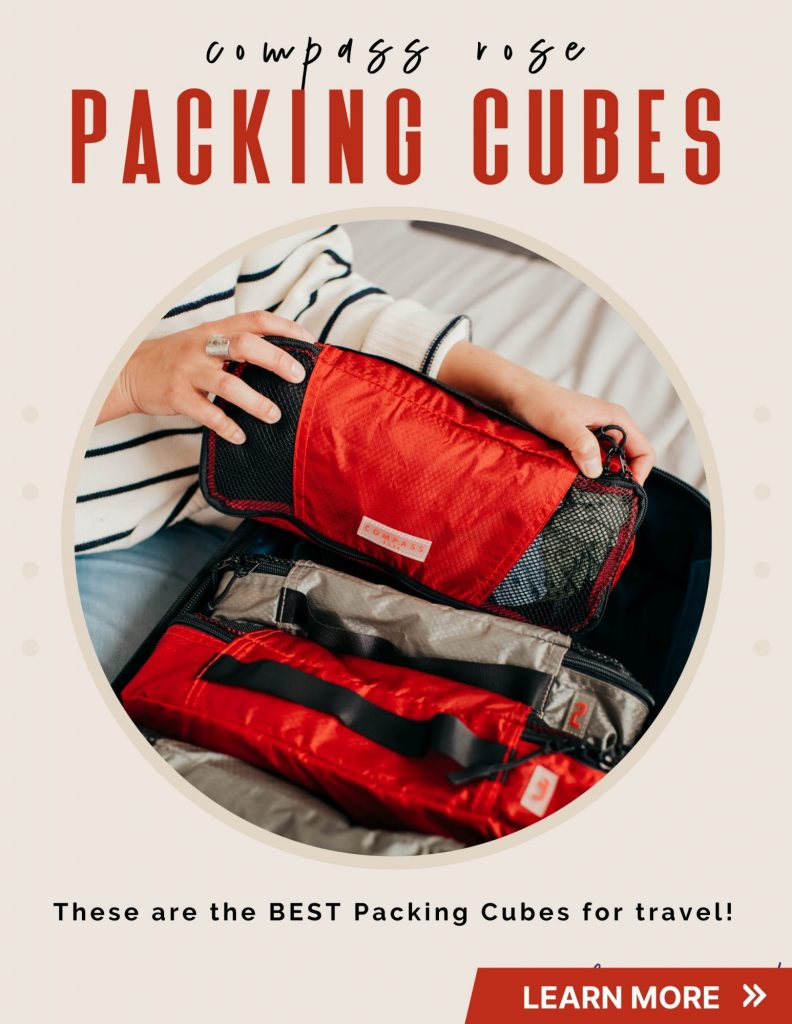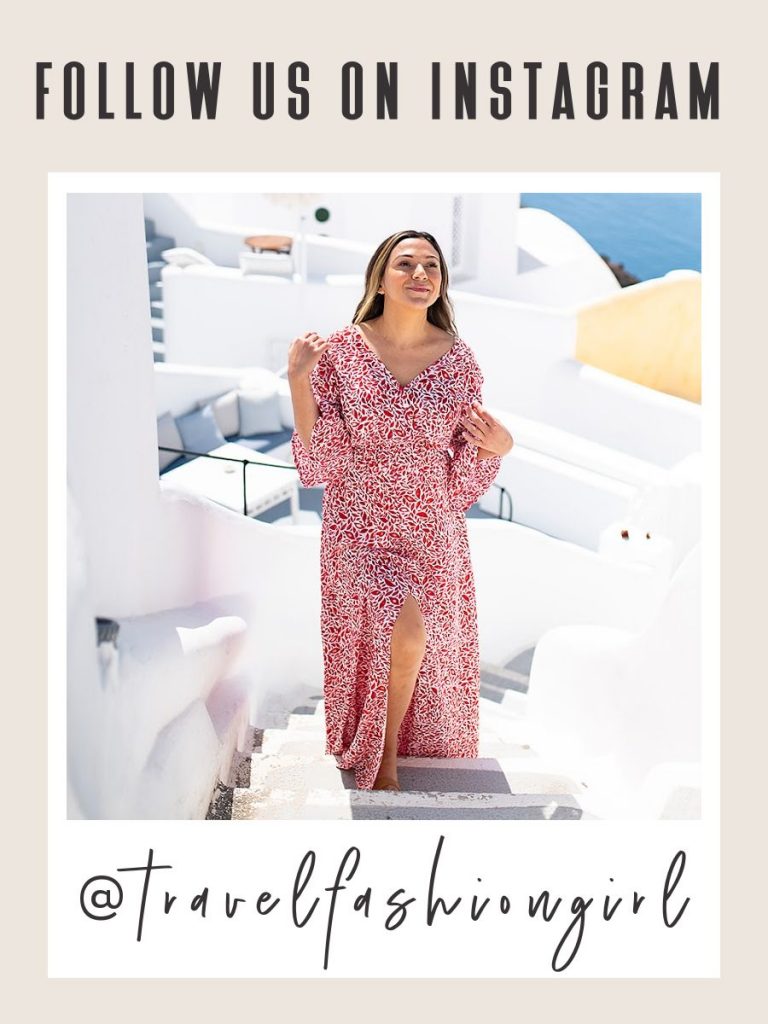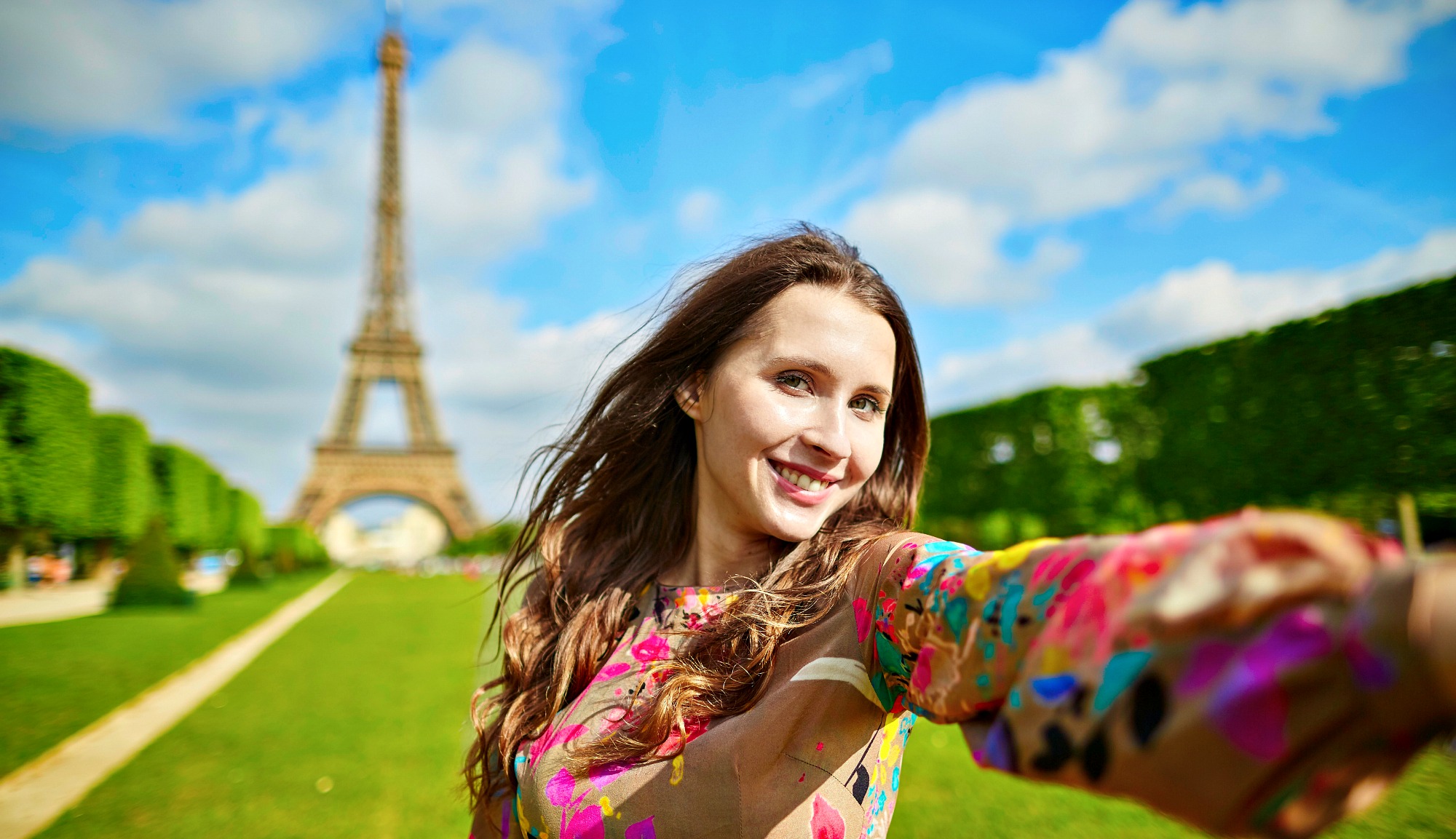
For this sample packing list for backpacking Europe, we’ve planned an itinerary for you that includes: Rome, Paris, Zurich, Amsterdam, Barcelona, Budapest, Prague, Berlin, and London. You can use these guidelines whether you’re backpacking or on vacation.
Use this page for inspiration for a multi-stop trip and just add or replace your destinations. You can find tips for individual countries here!
This is a five part series. You can find the other seasonal packing list by clicking the thumbnails below and you’ll find the introductory guide here. Note: even if you’re NOT backpacking, these tips are still relevant to any trip.
Read PART ONE of this series and visit each seasonal packing list for more tips:
SPRING | SUMMER | AUTUMN | WINTER
Backpacking in Europe: Spring
While weather varies from city to city, these visuals will help you determine the 12 key pieces for backpacking in Europe in the spring. We emphasize warmth since the weather is so variable–check the forecast before you go and plan for layers!
Start by reading these general tips on packing for spring travel:
- How to Pack for Trips with Mixed Weather
- How to Layer a Summer Dress for Spring
- How to Pack for Europe in Spring
- Best Shoes for Traveling in Spring and Fall
If you need packing tips for another time of year, please read The Ultimate Backpacking Packing List for Europe.
EUROPE CLOTHING STYLE
Fashion in Europe is the same as other parts of the world. There are a variety of attire style preferences to reflect the tastes of different personalities. Don’t forget, Europe is a diverse region in terms of weather and style.
With the popularity of athleisure, over the years fashion across Europe, has become more “casual”, not to be confused with gym clothing.
However, casual or any other clothing in Europe generally tends to differ from some countries in the sense that people wear items that are fitted to their bodies. A tailored look is the true secret to the European everyday fashion observed by visitors.
As with most destinations, practical sense applies. Leave the beachwear for the beach because it doesn’t translate well to streetwear in a city. Unless you’re actually headed to the gym, you may want to consider not wearing gym attire.
While it’s not uncommon to wonder what do Europeans wear, it’s also important to remember that the best clothing to pack on any trip is what makes you feel most comfortable, both physically and emotionally because confidence is key to style everywhere around the globe.
Sample Packing List for Backpacking Europe in Spring

V Neck | Blouse | Shirt | Shirt | Dress | Jeans 1 | Jeans 2 | Shorts | Raincoat | Jacket | T-Shirt | Sweater | Loafer | Boots | Scarf | Backpack
2 DRESSES (OR SKIRTS)
Dresses are extremely versatile for travel. Read our ultimate guide to dresses for travel!
Black is great for the spring months and will allow you to easily mix and match with colorful footwear, cardigans, and jewelry. In addition, black will attract sunshine and provide you with added warmth.
On cooler days, the dress can be worn with a cardigan or jacket. Read this to learn what to wear on a rainy day when traveling. A popular way to wear dresses and skirts in Europe is to pair them with tights like these.
3 BOTTOMS
Jeans offer a modern, contemporary style and look great teamed with ankle booties.
Black is figure flattering, forgiving with dirt, and the best base to mix and match, allowing you to create a number of different looks. In general, dark denim such as a dark blue is recommended over light denim.
If you want to wear shorts for warmer destinations, dressier material creates a loose, sophisticated look, which is appropriate for a wider age group. If you don’t like shorts, pack an extra set of trousers or pants like these.
Leggings are comfortable with their stretchy waistband and fabric and can be paired with virtually anything. Black is the best color to use as your base.
Leggings are an essential if you’re backpacking in Europe in spring or any time of year because you can layer then under your jeans, skirts, or dresses. Just don’t wear them as pants! Check out the best leggings for women who travel.
5 TOPS
Plan to layer your clothing for the weather. Even in late spring, cold weather can still be expected in some parts of Europe. However, you have to check the weather forecast in advance (weather.com) in order to make the best clothing choices.
In general, it’s advisable to pack a selection of varying length tops when backpacking in Europe in spring. Avoid t-shirts (unless they’re a nice quality like these) and opt for dressier tops instead.
One short sleeve top could work as either a base for your outfits or to be worn alone on warmer days. You can team them with any bottom or use them to layer for the cooler days.
Bring three long sleeve tops in varying thicknesses and knit fabrics for cold days. If it gets really cold, you should be able to layer these together if needed.
Make sure to bring at least one dressy top. The design of this top will act as a focal piece for your wardrobe. The higher-quality material will ensure that you have a dressier option if you need it.
2-3 OUTERWEAR
Bring two-three pieces you can wear together when the temperatures drop. To save space, pack only one jacket to keep you warm and dry. If the majority of your clothing is in neutral colors, choose a colorful jacket and if your clothing is colorful choose a neutral color like these.
A v-neck cardigan would be comfortable and appropriate item to wear alone or layered when you need extra warmth. Alternatively, you can bring a sweater like one of theses to wear under your jacket.
While not suitable for the snow or temperatures under 45F, (faux) leather jackets are great for travel as they’re waterproof, durable, and timeless. Avoid outdoor waterproof jackets if visiting major cities and choose a stylish option like one of these.
Wear your leather jacket on warmer days instead of a heavy coat, or underneath a coat for the coldest days. Perfect for backpacking in Europe like this stylish traveler!
2-3 SHOES
It’s essential to have appropriate footwear when backpacking in Europe. You need shoes that are comfortable for walking for long periods, that are durable, waterproof, and stylish. Your footwear depends on your planned activities and personal preference.
One unexpected issue that many travelers discover once they get to Europe are the cobblestone streets.
While great to look at, stone streets aren’t always the easiest to walk on and can make for sore feet even if you don’t normally have discomfort. Depending on the city, these streets can also be hilly, slippery when wet, and uneven.
Popular shoe options include (click each item below for suggested styles):
- Ankle Boots for spring and autumn
- Stylish Sneakers for Year Round
- Waterproof Boots for rain and snow
- Comfortable Sightseeing shoes for year round visits
- Cute Comfortable Summer Sandals
Read this article on how to choose the best walking shoes for Europe.
Ankle boots are the preferred shoe for Europe in spring and summer. Find out why. They will keep your feet warm and dry during your travels. Choose (faux) leather for durability and comfort. They’re good for the rain, too!
Closed, flat shoes give your foot added support. White sneakers or slip-on sneakers are comfortable for walking. They are also easy to get on and off and are practical for traveling and day-time excursions.
In addition, we all love to dress up, but avoid heels because they’ll leave you feeling uncomfortable. For dressier shoes, skip the heels and bring cute and comfortable ballet flats or loafers. Instead of stilettos, opt for wedges. Do include one pair of shoes and one outfit that can be worn for dining out or experiencing the local nightlife.
These comfortable walking shoes are popular sightseeing shoes for Europe.. Remember, three pairs is the magic number!
EXTRAS AND ACCESSORIES
Tights: Add 2 pairs of tights to your packing list. Opt for one in sheer and the other in knit, which will give you added warmth. They’re perfect to layer under dresses, skirts, and pants, too!
Umbrella: Don’t be caught off-guard; carry a travel size umbrella inside your handbag in case you get caught in an unexpected rain shower.
Hat: Choose a knit option – it will add instant warmth on cold days and hide bad hair days!
Sunglasses: Make sure your eyes are protected with quality sunglasses with UV protection.
Scarf: Scarves are the perfect accessory for adding warmth and a touch of color and personality to an otherwise neutral outfit. Pick scarves in your preferred colors and patterns. I love these easy-to-wear infinity scarves.
Purse: Choose a crossbody purse or cute purse backpack. Find out how to choose the right purse to join you on your trip here.
Sun protection: Sunblock, sunglasses, hat, lipcare, etc. (If you forget these items, you can buy them at your destination.)
For individual countries, please refer to the corresponding packing list for Europe including advice directly from locals found here: TFG’s Europe Packing Lists.
Weather for Europe in Spring
This is a brief summary of the weather for the cities we’ve chosen for our sample backpacking in Europe itinerary: Rome, Paris, Zurich, Amsterdam, Barcelona, Budapest, Prague, Berlin, and London.
For the most accurate forecast during your exact travel dates, visit weather.com.
ROME
Rome has a Mediterranean climate with hot dry summers and mild, rainy winters. Summer is the most popular time to visit the city, which is situated on the west coast of Italy. Not only is the weather warm and sunny with relatively low rainfall, there are many cultural attractions and an energy about the city that makes it such a popular tourist destination.
Spring sees the temperatures rising and the hours of daylight lengthening, with an average between 59-74°F / 15-23ºC. However, the nights remain cool and you’ll need to pack something a little warmer to ward off the evening chill.
Get more tips in the Italy Packing List.
PARIS
Paris: the beautiful French city known for its culture, fine food and wine, haute couture, and all things fashion. The city has a temperate oceanic climate with warm summers and cold winters. Rainfall is moderate and steady year-round; rain showers are not uncommon.
The days grow warmer and longer during the spring, when the city comes alive. Although early spring can still be cool, later in the season the temperature will see an average of 68°F / 20ºC during the daytime.
When visiting Paris, it’s important to pack clothing for fine dining and dressing up as well as comfortable clothes for walking and sightseeing.
Get more tips in the Paris Packing List.
ZURICH
This is the largest city in Switzerland and contains picturesque countryside, breathtaking architecture, great cuisine, and cosmopolitan nightlife. With the beautiful Lake Zurich, forests, and the Alps just 30 kilometers to the north of the city, there are many reasons to want to visit.
Zurich experiences relatively mild climates and is characterized by its summer highs and a very cold winter.
Spring is a great time to visit. Flowers are blooming and daytime temperatures range between 59-68°F / 15-20°C. Wind during the day can make it feel cooler. Rain increases toward the end of the season, but in general, it’s sunny and clear.
Get more tips in the Zurich Packing List.
AMSTERDAM
Amsterdam is known to be a particularly rainy city (Europe’s 4th rainiest). It’s charming, beautiful, and filled with cobblestoned streets, flowers, and canals.
The spring season in Amsterdam sees longer daylight hours but is chilly. In the beginning of spring, there’s an average high of 48°F / 9°C and average low of 36°F / 2°C, which warms up to pleasant mid-teens later in the season; however, the nights remain cold.
Get more tips in the Amsterdam Packing List.
BARCELONA
Barcelona enjoys a Mediterranean climate of hot summers and mild winters. The city is beautiful and filled with museums and celebrated art. With its glorious beaches, sunshine, and constant celebrations and festivals, the infectious energy will enchant you.
Spring is a wet season although it’s also warm and sunny, with an average high temperature of around 68°F / 20°C and cooler nights around 50°F /10°C.
Get more tips in the Spain Packing List.
BUDAPEST
The beautiful capital of Hungary is filled with historical legacy, museums, and impressive architecture that consists of baroque, neoclassical, and nouveau buildings. The city experiences a continental climate with moderate rainfall and temperatures that are cold enough to support a fixed period of snow each year.
The spring season in Budapest is similar to autumn. Average highs are between 61-64ºF / 16-18ºC and the sky is clear and sunny.
Get more tips in the Budapest Packing List.
PRAGUE
The Czech capital is a bohemian-style city, rich with history and celebrated architecture. Prague’s climate is continental, with clearly defined seasons, hot rainy summers, and cold winters. Spring and autumn have unpredictable weather.
Like autumn, the weather during the spring is unpredictable and early spring is cold with average temperatures around 41°F / 5°C. As the season progresses, the temperatures begin to rise and can settle around 52-67°F / 10-20°C.
Get more tips in the Prague Packing List.
BERLIN
The German capital is a beautiful, vibrant city known for fashion, design, music, and art. The city experiences a temperate continental climate and receives all four climates with warm summers, cold winters, and moderate rainfall.
The daylight hours increase during the spring season and the temperature warms to average highs between 46-66°F / 8-19°C. However, the nights remain cold.
Get more tips with this Germany Packing List.
LONDON
One of the most visited and celebrated cities, London is rich with history, architecture, art, museums, and trendy cafes. London experiences a temperate maritime climate with four seasons and no extremes.
The spring season in London is unpredictable; the daylight hours increase and the temperatures can be pleasant with highs of around 68°F / 20°C while other days see a fall in temperature and are wet (spring is known for its frequent rain showers) with chilly days.
Get more tips in the London Packing List.
Read PART ONE of this series and visit each seasonal packing list for more tips:
SPRING I SUMMER I AUTUMN I WINTER
Find out what to pack for backpacking in Europe year-round:
Click here to go back to the main Backpacking Packing List for Europe.
Additional Travel Resources for Europe:
- Backpack Vs Suitcase: Which is Right for My Trip to Europe?
- Ultimate Guide to The Best Travel Purse for Europe
- Money Belts and Anti-Theft Travel Accessories
- 10-Step Packing Guide for Europe
- What to Wear in Europe: Packing List for Every Destination
LIKED THIS POST? PIN THIS PIC TO SAVE IT!
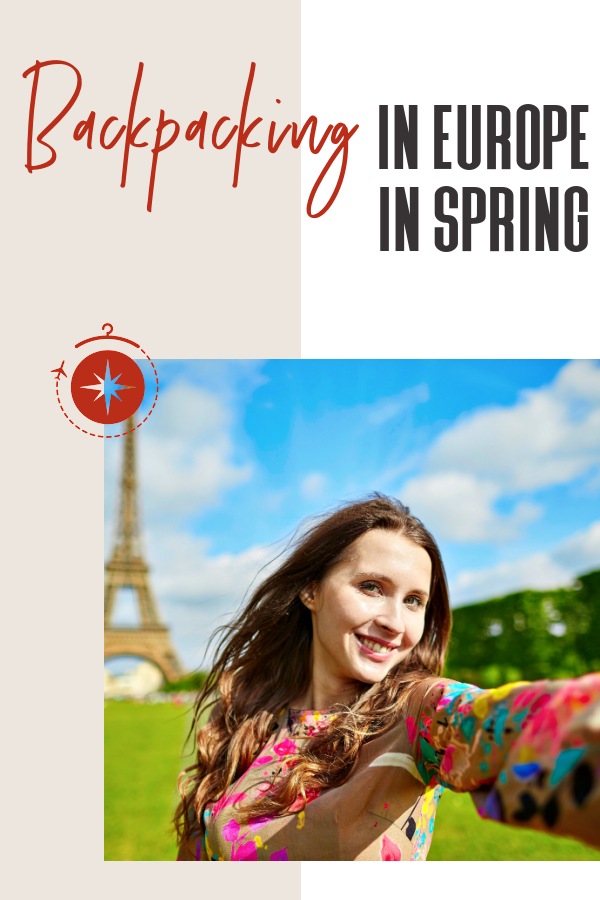
Now that you know what to wear when backpacking in Europe in spring, please comment with your own travel essentials. Don’t forget to share the love on Facebook, Twitter, and Pinterest. Thanks for reading!


